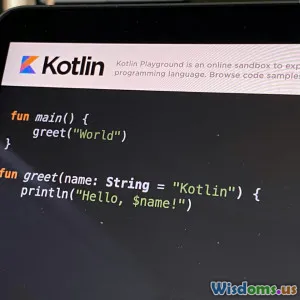
Unexpected Ways Python Simplifies Data Science Projects
8 min read Discover surprising Python features that accelerate and simplify data science projects beyond expectations. (0 Reviews)
Unexpected Ways Python Simplifies Data Science Projects
Data science, an ever-evolving field, demands tools that not only empower but simplify complex workflows. Python, often hailed as a top language for analysts and data scientists, is famous for its accessibility and versatility. But beyond its popular libraries like Pandas, NumPy, and scikit-learn, Python offers several unexpected ways that markedly reduce complexity and increase efficiency in real-world data science projects.
In this article, we'll dive deep into those less obvious but game-changing aspects of Python – from automation hacks to smart data handling techniques, and visualization tricks that save hours of work. Whether you’re a beginner curious about how to improve your workflow or an experienced data scientist aiming to streamline projects, these insights reveal powerful ways Python helps you get more done with less frustration.
1. Intuitive Scripting Beyond the Obvious
Seamless Integration with Shell and Automation
One surprising strength of Python lies in its seamless ability to automate repetitive tasks without leaving the comfort of code. While many users think of Python solely as a data processing tool, its built-in modules like os and subprocess enable executing shell commands as part of scripts, massively speeding up data pipeline tasks.
Real-world example:
Imagine a data pipeline where raw CSV files are automatically downloaded daily from a remote server, cleaned, and ingested into a database. Using Python’s paramiko or simply subprocess and cron jobs, you can automate the entire process, eliminating manual triggers.
import subprocess
# Simple example to download and unzip data files
subprocess.run(['wget', 'http://example.com/dataset.zip'])
subprocess.run(['unzip', 'dataset.zip'])
This integration frees data scientists from toggling between multiple environments and promotes reproducibility.
Quick Data Exploration with Jupyter Notebooks
Jupyter Notebooks combine code, narrative, and visualization in one neat package. But what makes them unexpectedly powerful is the ability to run snippets, test hypotheses quickly, and iteratively refine models. This contrasts with monolithic scripts that often grow large and unwieldy.
Jupyter’s support for Markdown and rich output formats enhances documentation directly alongside code, which saves time communicating findings.
2. Handling Messy Data Made More Manageable
Python’s Resilient Data Wrangling Libraries
Data rarely arrives clean, and Python’s ecosystem surprises many by how well it can manage incomplete or corrupted datasets. Libraries like Pandas are famed for their ability to handle NaNs flexibly, but supporting tools such as dataprep and great_expectations let you create robust validation and cleansing checks.
For instance, great_expectations allows the insertion of “expectations” which automatically flag anomalies or inconsistent formats before analysis begins, improving data quality systematically.
Natural Language Processing (NLP) for Text Cleansing
Working with textual data is notoriously tricky. Here, Python’s NLP libraries such as NLTK, spaCy, and TextBlob provide out-of-the-box functionalities like tokenization, stop words removal, and spell checking.
A real-world case is preprocessing customer reviews or social media feeds, where cleaning slang, emojis, and noise manually would be impractical. Python packages provide pipelines allowing you to focus more on analysis than on data cleaning minutiae.
3. Unexpected Visualization Capabilities
Interactive Dashboarding with Minimal Code
While tools like Tableau are popular, Python frameworks such as Dash and Streamlit allow data scientists to build interactive web applications without needing deep web development expertise.
This surprise element means you can:
- Prototype interactive analyses.
- Share tools directly with stakeholders.
- Update underlying data dynamically.
For example, with Streamlit, a few lines can generate a dynamic dashboard:
import streamlit as st
import pandas as pd
import numpy as np
data = pd.DataFrame(np.random.randn(10, 3), columns=['x', 'y', 'z'])
st.line_chart(data)
Custom Visualization Beyond Defaults
Python’s Matplotlib and Seaborn are often seen as basic plotting libraries, but they allow detailed customization that many don’t leverage. By directly manipulating plot elements, colors, and styles, you can create publication-quality graphics with full control – without relying on preset templates.
Additionally, libraries like Plotly enable interactive complex graphing, extensively used in finance and scientific research for detailed data drilldowns.
4. Machine Learning Pipeline Automation
AutoML Python Packages
Python simplifies machine learning workflows unexpectedly through AutoML libraries like auto-sklearn, TPOT, and Google’s AutoML client libraries. These tools automate algorithm selection, hyperparameter tuning, and model validation.
This automation lets data scientists focus on problem framing and interpretation rather than exhaustive manual experimentation. For example, TPOT uses genetic programming to explore pipelines efficiently without costly trial and error.
Reproducibility and Version Control Integration
Robust data science projects require traceability. Python integrates smoothly with version control systems like Git, but beyond code, libraries such as DVC (Data Version Control) allow tracking dataset versions and ML model artifacts.
This unexpected synergy encourages better collaboration, easier rollbacks, and reproducible experiments – essential in corporate or regulated environments.
5. Community-Driven Innovations and Plugins
The broad Python data science community continuously creates plug-ins and enhancements that stay under the radar but yield great time-savers—extensions for performance like Numba for JIT compiling, lightweight database ORM mappings like SQLAlchemy, and enhanced I/O functionality to handle various data formats seamlessly.
Moreover, platforms like PyPI and GitHub provide countless open-source projects addressing niche problems. Discovering tailored tools can greatly simplify aspects of your data science challenges.
Conclusion: Embracing Python’s Hidden Strengths
Python’s reputation as a data science tool isn’t accidental. Beyond its famous libraries and user-friendly syntax lies a rich set of functionalities, integrations, and community contributions that unexpectedly simplify complex data projects.
From automating pipelines, cleansing messy data intelligently, to creating interactive visualizations, and even automating machine learning workflows—these facets collectively reduce development time and cognitive load. Anyone invested in crafting effective, efficient data science workflows owes it to themselves to explore these Python features and patterns that can transform data challenges into streamlined processes.
As the data landscape evolves, Python remains robust not only because of what is obvious but also the surprising simplicity hidden beneath. It’s a toolkit waiting to be fully mined, so start experimenting and unlock new potentials in your data science journey.
Rate the Post
User Reviews
Other posts in Artificial Intelligence
Popular Posts


















